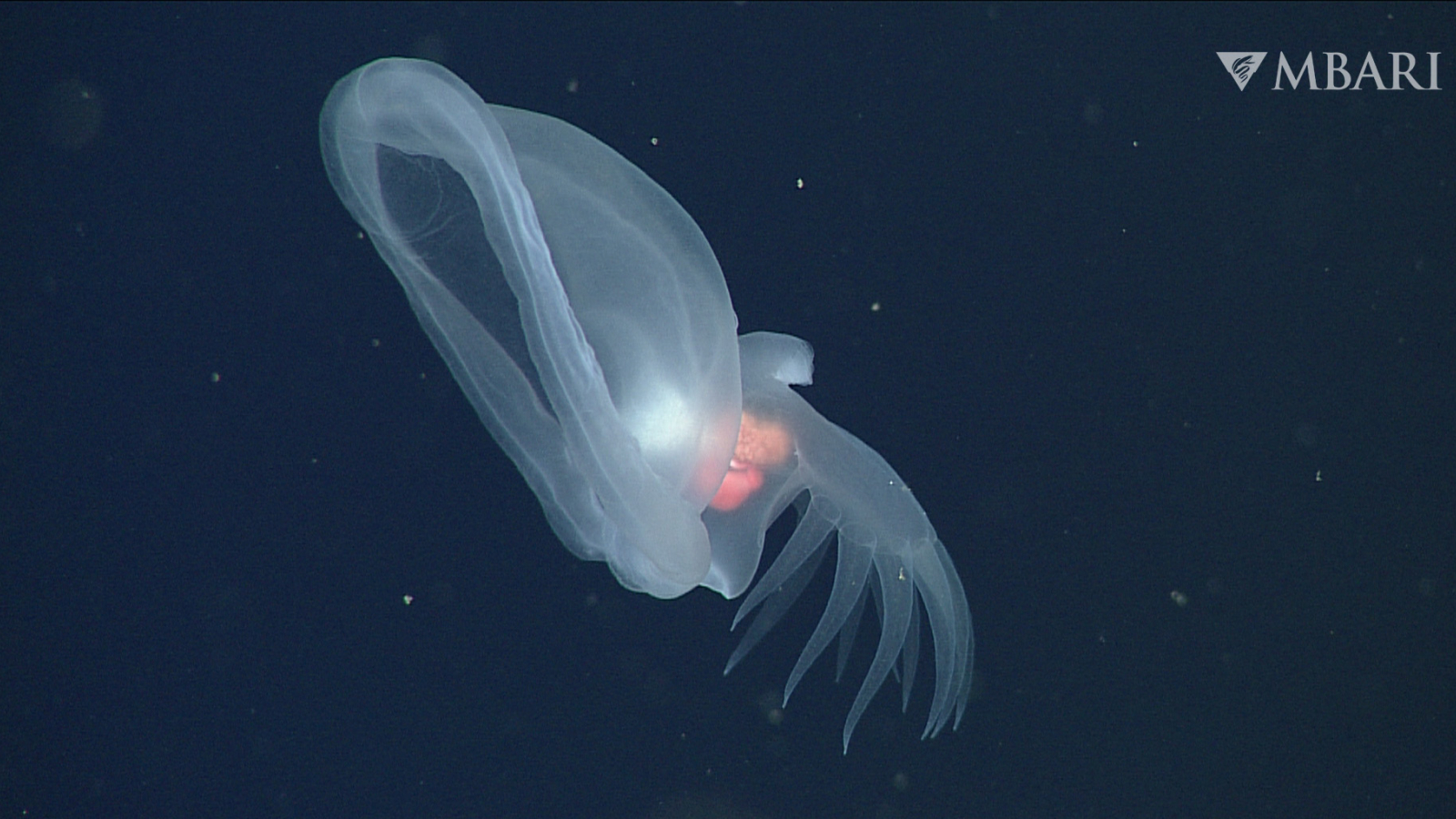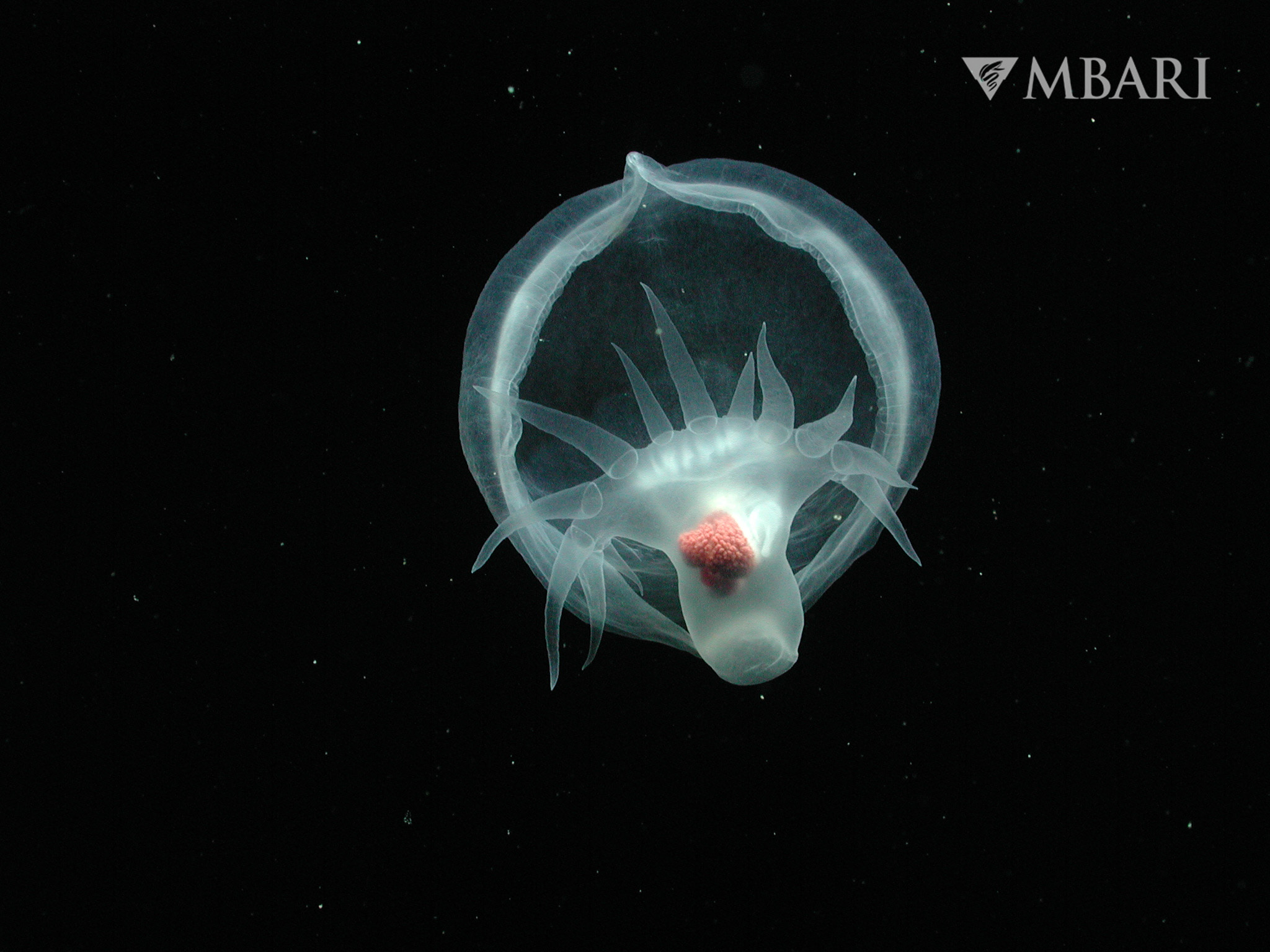Glowing mystery sea slug that feeds like a Venus fly trap captured in deep sea footage for 1st time
Deep-sea researchers have discovered a strange glowing sea slug off the coast of California that lives in the water column — unlike most other species of its kind.

Hypnotizing footage reveals a never-before-seen swimming sea slug that eats using a large jelly-like hood and glows to defend itself from predators.
Living at depths of between 3,300 and 13,100 feet, (1,000 to 4,000 meters), the mystery mollusc (Bathydevius caudactylus) is the first nudibranch species found living in the deep water column. Researchers first captured footage of the animal in February 2000 using a remotely operated vehicle (ROV) off the Monterey Bay coast. They spent the next 20 years learning more and gathering enough information to publish the most comprehensive description of a deep-sea animal to date.
Nudibranchs, or sea slugs, usually live and feed on the seafloor, but the newly described bioluminescent species swims through the ocean's midnight zone, deep below the surface. The newfound species is 5.6 inches (14 centimeters) long with an enormous gelatinous hood, a fringed tail, colorful organs visible through its translucent body, and a foot, like a snail.
At first, the researchers couldn't figure out what this strange animal was, so they nicknamed it the "mystery mollusk." When they got it back to the lab, anatomical and genetic tests confirmed it was a nudibranch.
It is so distinct from other known nudibranchs that the researchers created a new family: Bathydevius, which refers to the way this "devious" animal fooled researchers with its unique features. It was given its species name caudactylus thanks to the finger-like projections, or dactyls, on its tail.
"We were extremely surprised to find that Bathydevius is a nudibranch, partly because it doesn't look like the others, but also because this is such an unusual habitat for a nudibranch," Bruce Robison, senior scientist at Monterey Bay Aquarium Research Institute (MBARI), told Live Science via email. Robison led the efforts to describe the mystery mollusk.
"Most nudibranchs live on the seafloor in shallow water and feed on attached prey," he said. "Moving into the deep water column and feeding on free-swimming, fast-moving prey is a real challenge."
Get the world’s most fascinating discoveries delivered straight to your inbox.

Researchers at MBARI published everything they know about this bizarre animal — through more than 150 sightings across a 20-year time period — on Nov. 12 in the journal Deep-Sea Research Part I.
The sea slug's translucent body likely protects it from being seen by predators, Robison said.
The scientists believe the mystery mollusk uses its hood like a Venus fly trap to catch crustaceans to eat. The hunting technique is used by several other sea creatures. "Several unrelated animals, including the large jellyfish Deepstaria and fragile comb jellies, entrap their prey in what looks like a living grocery bag," co-author Steven Haddock, senior scientist at MBARI, told Live Science via email. "It's like throwing a rope net to stop a charging lion."
Although the mystery mollusk feeds in a similar way to the lion's mane nudibranch (Melibe leonina) and the veiled nudibranch (Tethys fimbria), these species are only distantly related, so this is a case of convergent evolution.
"Given the genetic separation from all other nudibranchs and its radically divergent body plan, it seems clear that this is a successful evolutionary experiment," Robison said.
When under threat, the mystery mollusk uses bioluminescence to distract its predators. In one instance, researchers saw it detach a bioluminescent limb as a decoy, similar to a lizard dropping its tail.
The mystery mollusk is known to live in the northeastern Pacific Ocean, from Oregon to Southern California. However, experts believe its distribution could be more widespread, as NOAA researchers have observed a similar-looking animal in the Mariana Trench — the deepest part of the ocean, located in the Western Pacific.
The experts still want to solve the puzzle of how this animal feeds. "We know what it eats but we can't figure out how this slow-moving sea slug can capture those very fast shrimp," Robison said.

Melissa Hobson is a freelance writer who specializes in marine science, conservation and sustainability, and particularly loves writing about the bizarre behaviors of marine creatures. Melissa has worked for several marine conservation organizations where she soaked up their knowledge and passion for protecting the ocean. A certified Rescue Diver, she gets her scuba fix wherever possible but is too much of a wimp to dive in the UK these days so tends to stick to tropical waters. Her writing has also appeared in National Geographic, the Guardian, the Sunday Times, New Scientist, VICE and more.



